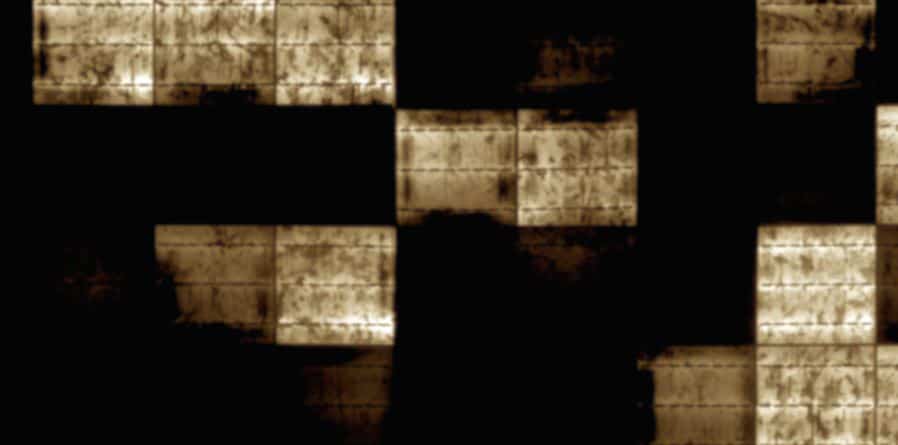The affected modules were delivered in 2011 and installed in various projects in Germany. Then, at the end of 2014, employees in the control center of an operations management company noticed an “uncharacteristic drop in performance” in some of the inverter stations. The employees’ initial hunch was, “This looks like PID.” After taking some random measurements and a number of electroluminescence images, their suspicion was confirmed.
They found that the PID effect only occurred in certain batches of modules from a particular manufacturer. The operations manager who contacted us checked this manufacturer’s modules, whose combined capacity was some 200 megawatts. After the manufacturer was informed of the drop in performance, it quickly began taking its own measurements. The company was then open and transparent in its communication of the measurement results, says the operations manager. The measurements indicated a PID effect in just over 20 percent of the monitored inverter stations. A total of three solar farm operators were affected.
Interested in discussing the question raised?
Come to our roundtable at SPI in Las Vegas, 12 p.m. to 2 p.m. on September 14.
-> More information
If you have examples of poor quality modules or installations and interesting discussion points – pv magazine would be interested in your story and will treat all submissions with the utmost confidentiality.
-> More information
To register for free, email us at:
-> roundtable@pv-magazine.com
Working together to find a solution – with no help from the inverter manufacturer
In this case, the operators had the good fortune of dealing with a manufacturer that took them seriously. According to the operations manager, the manufacturer immediately expressed its willingness to take steps, together with the operator and the operations manager, to mitigate the problem. But what to do?
In this case, it was not the PV panel manufacturer but the supplier of the inverters who created complications. Initially, the parties involved considered integrating so-called anti-PID boxes into the DC power circuits of the affected strings. Such devices apply reverse voltage to the PV panels of a string during the night. That prevents a progressive drop in performance. With this technique, it is also theoretically possible to partially or even completely reverse the PID effect, practically healing the modules. The problem with this solution, however, was that the inverter manufacturer was not on board. It did not offer its own such products, and it did not want to cover potential problems caused by anti-PID boxes from another manufacturer.
The parties to the contract then agreed to another solution: module strings connected to the affected inverter stations were grounded. Grounding can also prevent the PID effect from getting worse. The operations manager also reported that after three months the healing process was measurable and that it had even partially reversed the previous PID-related degradation.
Grounding and occupational safety
Although grounding the strings was technically possible due to the galvanic separation of the DC and AC circuits, it involved yet another challenge. Grounding the strings meant that isolation faults, such as an undesired ground short-circuit, could not be easily identified and repaired. Without the grounding, there is an isolated and monitored DC network with two-fault safety, explains the operations manager. With the grounding, there was merely a single-fault safety.
-> “Poor quality planning: Shifting the blame, passing the buck”
-> “Melting backsheets, broken cells, and hotspots”
-> “Burnt out, incompatible connectors”
Further Roundtable material:
-> Interview with George Touloupas, Director of Technology and Quality at CEA
“Minor differences in yield percentage make the difference between good and bad investment”
To counteract this potential hazard, the operator and operations manager decided to install a safety circuit. This ensures that the PV farm automatically reverts to the non–grounded and monitored state as soon as someone deactivates the unauthorized entry alarm of the farm and enters the facility. Furthermore, the safety circuit is integrated into the monitoring system of the plant.
Unlike the grounding work, the cost of the safety switch was not covered by the module manufacturer. The costs were absorbed by the owner of the PV farm. “That was basically the only unpleasant point in the discussion with the manufacturer,” says a spokesperson for the operations manager. Otherwise, both the owner of the farm and the operations manager were very satisfied with how the manufacturer dealt with the problem.
Please share your thoughts with pv magazine at roundtable@pv-magazine.com
Building a Sustainable Future for Large-Scale Solar PV in the U.S.
- 12 p.m. to 2 p.m. on September 14, 2016 during SPI in Las Vegas
- Springhill Suites at Las Vegas Convention Center
- Register at no cost at: roundtable( at )pv-magazine.com
- Target audience: Asset managers, EPCs, operations & maintenance suppliers (O&M), system designers and independent engineers, financial institutions, insurance companies, investors, system owners (utilities, gencos, IPPs, as well as C & I system owners), certification and testing bodies, research institutes and universities, industry associations, government entities, codes & standards and regulatory agencies.
- MCs: pv magazine
- More information
| Initiative sponsor partner: | Gold sponsor: | Gold sponsor: |
 |  | |
| Supported by: | Supported by: | |
 |
This content is protected by copyright and may not be reused. If you want to cooperate with us and would like to reuse some of our content, please contact: editors@pv-magazine.com.









By submitting this form you agree to pv magazine using your data for the purposes of publishing your comment.
Your personal data will only be disclosed or otherwise transmitted to third parties for the purposes of spam filtering or if this is necessary for technical maintenance of the website. Any other transfer to third parties will not take place unless this is justified on the basis of applicable data protection regulations or if pv magazine is legally obliged to do so.
You may revoke this consent at any time with effect for the future, in which case your personal data will be deleted immediately. Otherwise, your data will be deleted if pv magazine has processed your request or the purpose of data storage is fulfilled.
Further information on data privacy can be found in our Data Protection Policy.